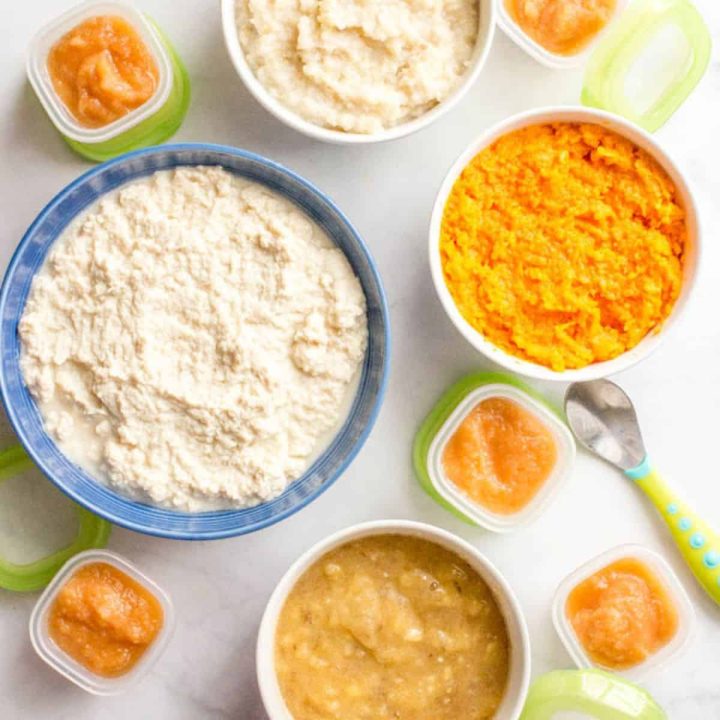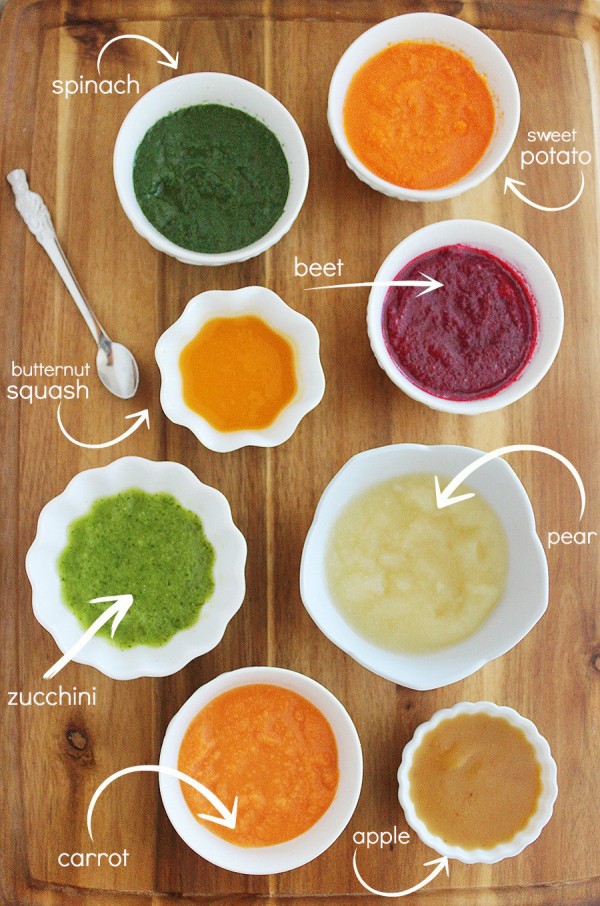Homemade Baby Food Recipes: Nutritious & Easy Ideas
- Update Time : Wednesday, May 1, 2024

Homemade baby food recipes offer a nutritious alternative to store-bought options. They allow full control over ingredients and can be tailored to your baby’s needs.
Creating homemade baby food is a proactive approach to ensure your infant’s health and well-being. Parents who choose to make their baby’s food at home can select fresh, high-quality ingredients, avoiding preservatives and additives found in commercial products. This hands-on method also introduces babies to a wider variety of tastes and textures, which can aid in developing their palates and fostering good eating habits early on.
With a focus on simplicity and nutrition, homemade baby food recipes typically involve steaming and pureeing fruits and vegetables, or gently cooking meats until they are safe and soft enough for baby’s consumption. By preparing these meals, parents can ease the transition to solid foods and provide a foundation for a lifetime of healthy eating preferences.

Credit: www.familyfoodonthetable.com
The Benefits Of Homemade Baby Food
Making baby food at home ensures freshness and top nutrition. Parents control the ingredients, avoiding preservatives and unwanted sugars. Fresh ingredients mean more vitamins and minerals for your baby’s growth.
Homemade baby food adapts to specific dietary needs easily. Whether your baby needs low-allergen meals or special nutrients, custom recipes are simple to create.
Getting Started With Baby Food Preparation
Preparing homemade baby food needs specific kitchen tools. A steamer keeps nutrients in vegetables. Use a blender to make purees smooth. Ice cube trays are great for freezing small portions.
Keep baby’s food safe by washing your hands before cooking. Always clean surfaces and tools. Cook food thoroughly to kill germs. Let food cool before serving.
| Tool | Use |
|---|---|
| Steamer | Locks in nutrients |
| Blender | Creates smooth purees |
| Ice Cube Trays | Freezes food in portions |
Understanding Baby’s Nutritional Needs
Nutrition is vital for your baby’s growth. Your little one needs different vitamins and minerals to grow healthy and strong. These include vitamin A, vitamin C, calcium, and iron. Proper balance of proteins, fats, and carbohydrates is also key. Babies need more fat than adults to support their rapid development.
Make sure to include a variety of foods to cover all nutritional needs. Fruits and veggies are great for vitamins. Whole grains give energy. Meats and beans provide protein. Remember, always talk to a doctor before making changes to your baby’s diet.

Credit: blog.pamperedchef.com
First Foods: Recipes For The Youngest Eaters
Introducing your baby to solid foods is an exciting journey. Homemade purees ensure that your little one gets fresh and nutritious meals. Begin with single-ingredient purees to check for any allergies. Common first foods include banana, avocado, and sweet potato. These are easily digestible and rich in nutrients.
To prepare, simply steam or boil the vegetable or fruit until tender. Next, blend it into a smooth texture using a food processor or blender. You can add a little water, breast milk, or formula to achieve the desired consistency. Remember to cool the puree before feeding it to your baby. Always store leftovers safely in the refrigerator.
Exploring Flavors: Introducing Variety
Introducing a variety of flavors to your baby’s diet is exciting. Start by combining fruits and vegetables that complement each other. Think about mixing sweet apples with earthy carrots, or creamy bananas with vibrant spinach. These combinations not only offer a range of nutrients, but also help your little one develop a palate for different tastes.
Don’t shy away from using herbs and spices in homemade baby food. Gentle herbs like cinnamon, mint, or basil can be great additions. They add flavor without the need for salt or sugar. Remember, a small pinch is enough to introduce these new tastes to your baby.
Finger Foods: Encouraging Self-feeding
Introducing finger foods to babies can be both fun and important for their growth. Soft bites that are easy to grab are perfect for tiny hands. Think about using ripe bananas, steamed carrots, or small pieces of avocado. Cut these into small, manageable pieces.
For skill development, offer dippable options. Applesauce, yogurt, and pureed fruits work well as dips. Pair them with strips of toast or cooked vegetables. This encourages babies to practice dipping and brings joy to mealtime. Keep the pieces appropriate for their age to avoid choking hazards.
Identifying potential allergens in homemade baby food is crucial. Common allergens include eggs, dairy, nuts, and wheat. Start with single-ingredient meals. Watch for any signs of reaction, such as rash or fussiness.
For creating allergy-friendly menus, focus on a variety of safe foods. Rotate ingredients to promote nutritional balance. Use fruits, vegetables, and meats that your baby tolerates well. Always consult with a pediatrician before introducing new foods.
Storing And Freezing For Convenience
Storing homemade baby food requires care. Use airtight containers or ice cube trays to keep food fresh. Label each container with the date of preparation. This helps you track how long the food has been stored. Baby food should be kept in the freezer for a maximum of 3 months. It’s best to thaw frozen baby food in the fridge and not at room temperature. To reheat, choose a method that heats the food evenly. Always stir food well and test the temperature before feeding your baby. It’s important to discard any leftovers to avoid bacteria growth. Never refreeze thawed baby food.
Meal Planning For Busy Parents
Batch cooking saves time and ensures your baby has healthy meals ready. First, pick one day a week for cooking. Prepare several meals at once. Use simple recipes that freeze well. Separate them into small portions and store them safely.
To keep meals exciting, plan a variety of dishes each week. Include different fruits, vegetables, and proteins. This approach helps expose your baby to new tastes. Rotate the menu weekly to maintain a balanced diet.
Transitioning To Table Foods
Introducing textured foods to your baby should start around 6 to 9 months. It’s a key step for them to learn eating. Soft, mashed foods can be a good start. Your little one can move to more solid foods as they grow.
Make meals fun and safe for toddlers by cutting foods into small, bite-sized pieces. Cook veggies until they are soft enough to mash with gentle pressure. Offer a variety of colors and shapes to make their plate exciting. Always keep an eye on them to prevent choking.

Credit: www.thecomfortofcooking.com
Frequently Asked Questions
What Homemade Food Can Babies Eat?
Homemade baby food can include mashed fruits like bananas, pureed vegetables such as sweet potatoes, blended chicken, and rice cereal. Always ensure foods are soft and adequately prepared for the baby’s developmental stage.
What Foods Can I Puree For My 5 Month Old?
For a 5-month-old, pureed fruits like bananas, apples, and pears, as well as vegetables like carrots, sweet potatoes, and squash, are suitable. Always introduce new foods gradually and consult with a pediatrician.
What Veggies To Mix For Baby Food?
Mix soft, nutrient-rich veggies like sweet potatoes, carrots, peas, and squash for baby food. These can be steamed, pureed, and combined for a healthy meal.
What Food Can I Give My 4 Month Old Baby?
At 4 months old, babies can start trying solid foods like pureed fruits and vegetables. Rice cereal mixed with breast milk or formula is also a common option. Always introduce new foods slowly and one at a time to monitor for allergies.
Conclusion
Embracing the art of crafting homemade baby food empowers you to nourish your little one with wholesome goodness. These recipes guarantee a healthy start, filled with flavor and essential nutrients. Dive into the joy of meal prep that’s both rewarding and budget-friendly.
Your baby’s smile with each bite is the best feedback you could ask for. Happy cooking!

















Leave a Reply